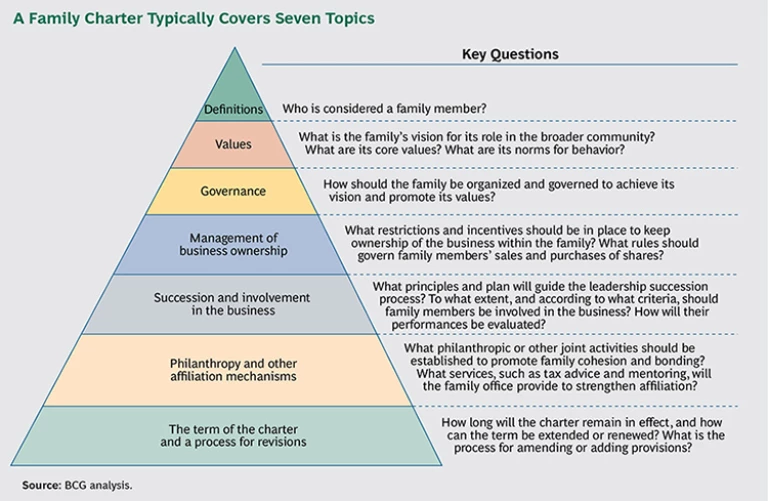For many family businesses, growing the enterprise may seem easy compared with what comes next: sustaining its success, ensuring smooth leadership transitions, and managing shareholder changes while also building an enduring legacy for generations to come. A family charter—also known as a constitution or protocol—can help to promote these long-term goals. Such a document can codify essential rules, responsibilities, and obligations relating to the ownership and management of the business, as well as set out the values that will guide family members’ conduct in the broader community. Although specific provisions must be tailored to any given family’s distinctive situation, philosophy, and culture, all charters should address a common set of issues.
Why Is a Charter Important?
Families that draft an effective charter capture important benefits, both tangible and intangible. A well-drafted charter can, for example, facilitate a smooth process for leadership succession—a very tangible benefit. Failing to establish and codify a formal plan for succession may produce disastrous consequences for a family business. (See “ Succeeding with Succession Planning in Family Businesses ,” BCG article, March 2015.) BCG research has found a 14-percentage-point differential in revenue growth over two years when comparing family businesses that had planned transitions with those that had not. Market capitalization growth—as well as margins for earnings before interest, taxes, depreciation, and amortization—also suffered significantly in the absence of careful planning.
In terms of intangible benefits, a charter can help family leaders build a strong legacy and forge domestic bonds that endure for generations. For example, members of the Wendel family have worked together as industrialists and investors in France for more than 300 years. The family, which has more than 1,000 members today, maintains its legacy through charter provisions that promote unity and affiliation.
A charter plays a particularly important role during transitions that create stress on the business and on family bonds, such as during leadership succession, divestiture of the original business, or investment of capital in a new business. A charter that provides clear guidance can also help relieve the stress that may accompany the rise of a new generation—particularly when that event significantly increases the number of family members in the business, which often occurs by the third or fourth generation.
For example, the son of the founder of one family business has maintained strong control of the enterprise for many years, but plans to turn over leadership to an executive from outside the family. To ensure that they can maintain oversight of the company, family members drafted a charter that set clear rules regarding their service on the board of directors and the allocation of seats. They also recognized that the family would need to strengthen its bonds, develop its culture, and perpetuate its legacy outside the business context. The charter became the document through which family members described the services and activities that they would pursue in the broader community to achieve these intangible objectives.
Despite such benefits, some families with successful businesses choose not to create a comprehensive family charter—perhaps believing that they can do without written rules to clarify responsibilities or establish standards of acceptable behavior at the individual or family levels.
Other families do create charters—but ineffectively. The provisions, for example, might not be specific enough to guide decision making when critical issues arise, such as leadership succession or the unanticipated sale of shares by a family member. Perhaps the charter is written in legal jargon that is hard to interpret and, as a result, fails to offer practical guidelines for family members’ behavior.
The Seven Topics That Charters Should Include
Comprehensive family charters typically cover seven broad topics, each of which encompasses several issues. (See the exhibit.) The depth and detail provided for each topic will vary depending on the family’s context, but including all the topics is essential.
Definitions. It is usually accepted that founders of a family business and their children count as family members for the purposes of the enterprise. When the younger generation then has children, however, determining membership in the family may not be as simple. Family members must agree on who qualifies as “family members and their descendants” with rights and responsibilities in the business and associated activities. The agreed-upon definition should be set out in the family charter. Within the bounds of local law, the definition should specifically address the status of current spouses, divorced or widowed spouses, and adopted or extramarital children.
Values. Many families honor the values upon which the business was founded by codifying them in the family charter, and they do so in a wide variety of ways. For example, some families express support for specific societal interests, such as education and health. Others prohibit members from engaging in particular industries or business practices on the basis of religious beliefs. Still others go further by setting out a code of conduct that guides the behavior of family members as it relates to the family’s standing in society. Issues addressed in a code of conduct may include whether family members may use the family name in independent business ventures or to publicly support political parties, as well as how they should interact with the media.
Governance. To successfully manage the transitions described above, as well as daily decision making, a family needs agile governance and clear management structures that are supported by a simple, yet robust, platform of processes and systems. (See “ Governance for Family Businesses: Sustaining the “Magic” for Generations to Come ,” BCG article, October 2014.) The family charter should outline the system of governance bodies—including the board of directors, family council, family assembly, family foundation, and their supplementary committees—for the family business or philanthropic activities, taking care to specify each body’s roles, responsibilities, and membership, and how the bodies will interact.
Management of Businesses Ownership. A family charter should specify mechanisms that will promote the business’s continued existence as a family-owned company. Without such mechanisms, disputes over succession or other major transitions could tear apart the family and its business. Some family members, for instance, will go so far as to sell their shares to outside investors if they do not get their way in disagreements. To maintain control of ownership and investment decisions, families can apply both restrictions and incentives. They can restrict the sale of shares to outside investors, for example, by giving other family members a right of first refusal (subject to any limitations on their ownership percentages) or by prohibiting sales to specific types of investors. They can encourage family members to keep their shares by, for example, instituting a generous dividend policy or providing loans to finance the payment of inheritance taxes.
Succession and Involvement in the Business. A charter should articulate principles that will guide the leadership succession process, including the circumstances under which a family member may be considered for the CEO’s role, and codify a formal plan for choosing a successor. It should also clarify family members’ roles and responsibilities in running the business and making investment decisions. The charter should describe the capabilities and skills required for serving on the board of directors or other governance bodies and committees. And to avoid conflicts of interest among family branches, the charter should prescribe clear rules regarding family members’ employment in the business—or even prohibit such employment altogether when appropriate. Talent management issues should also be covered. The charter can establish performance evaluation standards and mechanisms to ensure that family members employed in the business receive honest and constructive feedback. Further, to avoid transferring wealth from the family business to individual members, the charter can set rules regarding payment to a family member’s separate business for services rendered.
Philanthropy and Other Affiliation Mechanisms. Beyond developing and sustaining their business and wealth, many family businesses strive to strengthen their bonds of affiliation by fostering emotional connections among family members. These bonds help to create a common sense of purpose and steer the family toward collaboration and consensus on major issues. The family charter can set out opportunities for joint engagement that may strengthen these bonds, such as philanthropic activities and annual retreats. The charter can also establish other mechanisms for strengthening affiliation, such as having the family office provide advice on tax and legal issues and mentoring on business topics and values. (See “ What Does It Take to Set Up an Effective “Family Office”? ” BCG article, April 2015.)
The Term of the Charter and a Process for Revisions. The charter should specify how long it will remain in effect—though the term should be at least a generation to fulfill the charter’s purpose as the foundational document for the family’s activities. In addition, the charter should spell out how long and by what process the term can be extended or renewed. For example, the charter could have a fixed duration, after which time the family could consider creating an entirely new document. A charter should also be adaptable to accommodate the family’s changing needs over time. To enable flexibility, the charter should specify the process for revoking or renewing the entire document or amending or adding specific provisions. For example, it should indicate the percentage of family members required to approve changes to its term or provisions.
Putting Pen to Paper
The nature of a charter’s provisions is certainly important for maintaining family cohesion. But the process a family uses to draft those provisions is equally important. An iterative and open process will foster collaboration, encourage consensus, and lend weight to the rules and standards set out in the charter. Conversely, a document imposed in an authoritarian way is unlikely to be widely accepted by family members—especially if it restricts their behavior or activities.
Although lawyers and other advisors can provide essential support, a team of family members—typically selected by the family council—should be involved in drafting the charter from the outset to ensure that it reflects their needs, values, and aspirations. The team should begin the process by meeting with leading family members individually to discuss their views on the basic principles underlying the family’s governance and affiliation. When the team begins drafting the charter, it should address the topics it considers to be the most contentious or critical first and then turn to additional topics and details. External advisors can support the effort by helping to resolve problematic issues and facilitate a consensus on solutions, as well as by drafting technical provisions.
The process for developing the charter should take place apart from the regular activities of the family council or assembly. Business-as-usual activities should not be allowed to affect the charter development process and vice-versa.
It is also important to establish clear timelines for the process, from defining the basic principles to drafting the charter’s specific provisions to signing the document. To avoid a protracted process, the team drawing up the charter should meet regularly to discuss the progress, reach a consensus, and draft provisions until the document is finalized.
Where Do You Stand Today?
To assess the need to prepare a charter, or to improve upon a current charter, families should consider the following set of questions:
- Is a major leadership transition on the horizon? Will the company choose a successor from within the family or appoint an executive who is not a family member? Has the family discussed how this transition will affect business oversight and family cohesion?
- Is a family member planning to sell a significant ownership share of the business? Has the family established clear rules regarding other family shareholders’ rights under such circumstances, such as creating a right of first refusal, setting share prices, and specifying limitations on ownership percentages?
- Is the family considering a major investment—such as entering a new industry or region—that will change the emphasis of its business activities? Would the family need to attract external shareholders to provide additional resources for the new investment? Has the family reached a consensus on how it will respond to these changes to its “DNA”?
- Is a new generation reaching adulthood and requesting a greater voice in decision making? Are mechanisms in place to allocate decision rights and responsibilities among more family members?
- Does an existing family charter cover the full range of business and family affiliation issues that might arise? Are potentially contentious issues addressed head on? Is the charter’s guidance clear and actionable, or is it obscured by technical jargon?
For many families, the answers to these questions will point to opportunities to thoroughly review their approach to the topics discussed above. By drafting a charter that codifies its governance and reflects its values, a family can help to sustain its success and preserve its legacy for generations to come.








